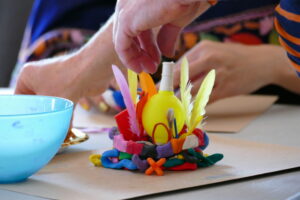Six Goals of the Art Therapy Program at Ledger (I)
A special guest post from Dawn Olson at Ledger House
To meet the range of needs presented by the children and teens at Ledger, a variety of activities are offered over the course of weeks and months. Three of the program’s six treatment goals are listed below, each accompanied by an example of what is done to achieve that goal.

- Decrease Anxiety and Increase Positive Emotion
In the mandala making session youth are asked to represent, with an image, a moment they have felt free. One depressed youth drew the wind and recalled the feeling of the wind through her hair as she rode her bike home from school. This image, and others, in her mandala, stirred positive emotion and even a sense of hope, replacing feelings of despair and emptiness.
- Increase Self-Confidence and Self-Efficacy
Activities are carefully selected to ensure that the chance of a successful outcome is high. Pulled string ink prints ask little of the artist, but reward them with intriguing, beautiful images which the children embellish with paint or chalk. Creating something they like and feel proud of surprises the children, helping them feel more confident and effective.
- Provide a Means for Healthy Expression of Emotion
Art therapy often involves using materials in a less controlled or spontaneous manner. Scribble paintings are one example of this. Teens are guided to stand and mimic scribble painting the ceiling with a dry brush. Then they scribble real paint marks on pieces of newspaper. Next, they search for a recognizable shape among the scribbles– perhaps they’ll see a branch, a child’s shoe, or a dog’s nose. Now, they add marks to fill out the image and the rest of the painting. This activity allows for projection: a process in which a person makes spontaneous associations between an outside object and what is going on in their own psychology and emotions. One teen was astonished as she looked at her finished painting and realized, ‘That’s me and my anxiety!’ The activity set the stage for her to record her anxiety on paper, to see it clearly reflected back to her and to speak about it in the group with matter of factness.
Part 4: Six Goals of the Art Therapy Program at Ledger (II) will be released on December 27.